
“Why do you cry, sister?” is an excerpt from Thich Nhat Hanh’s book, The Sun My Heart):
A few years ago, a pro-government group in Ho Chi Minh City spread a rumor that I had passed away from a heart attack. This news caused much confusion inside the country. A Buddhist nun wrote me that the news arrived at her community while she was teaching a class of novices, and the atmosphere in the class sank and one nun passed out. I have been in exile for more than 20 years because of my involvement in the peace movement, and I do not know this young nun or the present generation of Buddhist monks and nuns in Vietnam. But life and death is only a fiction, and not very deep; why do you cry, sister? You are studying Buddhism, doing what I am doing. So if you exist, I also exist. What does not exist cannot come into existence and what exists cannot cease to be. Have you realized that, sister? If we cannot bring a speck of dust from “existence” to”non-existence”, how can we do that to human? On earth, many people have been killed struggling for peace, for human rights, for freedom and social justice, but no one can destroy them. They still exist. Sister, do you think that Jesus Christ, Mahatma Gandhi, Lambrakis, Dr. Martin Luther King Jr. are “dead people?” No, they are still here. We are they. We carry them in each cell of our bodies. If you ever hear such news again, please smile. Your serene smile will prove that you have attained great understanding and courage. Buddhism and all of humankind expect this of you.
When I heard the news that Thay had passed away in 2014, I was weeping the whole day. There was a rumor spreading in Indonesia saying that Thay had passed away. Few hours later, we got the confirmation from Plum Village that Thay had not passed away. Thay had a stroke and many people thought that Thay would pass away. In the evening of that day, we had a gathering at Wihara Ekayana Arama with the monks, OI members, and other lay friends. We chanted Namo Avalokiteshvaraya and sent our energy to our beloved teacher, Thay.
At that time, my aspiration of going to Plum Village was watered very strongly. I wanted to be ordained as a monk since I met Thay in 2010, but my parents asked me to finish my study. I had to wait until I had finished my study in 2014, and it helped me to reflect on my aspiration whether I would really like to become a monk. Sometimes I regret that if I had decided to become a monk in 2010 and had gone to Plum Village at that time, I would have had a chance to be with Thay physically, and to receive his advice and guidance directly. I was able to come to Plum Village in 2015, when Thay was no longer able to speak. One time I had a dream of talking with Thay in Plum Village, and it made me very very happy.
When I was at the Wake Up Retreat in Thailand that was led by Thay in 2013, I saw a calligraphy on the slideshow, “You have seen the path. Do not fear anymore.” Then suddenly I was deeply moved to tears. I recognized that I had a fear that I wouldn’t be able to see Thay. That calligraphy was like encouraging words from Thay, comforting me that it’s not important to see Thay personally. It’s more important to be able to see the path.
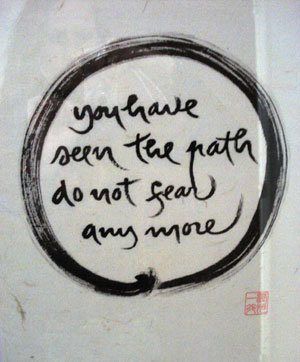
I received a lineage name, Chân Trời Đạo Bi, which means True Sky over the Path of Compassion. It helps me to see that my practice is to be able to see the Path of Compassion. “The Path of Compassion” is one of my favorite chapters in the “Old Path White Clouds”. It tells the story before Siddhartha became the Buddha. Siddhartha and Yasodhara were social workers, and they did not know how to overcome the sadness and grief in their hearts. Yasodhara was overwhelmed by grief when a young child she had tended for more than a week had just died. Siddharta tried to console her but he was not able to help her to overcome the grief because he had not yet been able to see the path. Only after Siddharta became the Buddha, then he was able to see the path of compassion and understanding.
I feel very fortunate that Thay has helped me to see this path. I have a lot of wounds as a social worker before I ordained, and I see that I am still on the path of healing my wounds. Knowing that I am on the path brings me a lot of happiness. The painful feelings of the wounds come up from time to time, but I have learned how to be with my wounds, and to understand my wounds. Thay always teaches us that understanding suffering is the way to generate compassion. Without suffering, compassion would not be. I see my wounds as the ingredients to grow compassion. When the wounds or suffering come up in me, I say to myself, “You have seen the path. Do not fear anymore”. This is like a mantra for myself. “Breathing in, you have seen the path. Breathing out, do not fear anymore”.
This mantra has been helpful to overcome my regret of not being able to see Thay, to embrace the fear and to remind myself that my practice is to be able to see the path. I feel grateful that I have been born in this spiritual life, as a disciple of Thay. I have learned a lot from Thay even though Thay is no longer able to teach verbally. Thay continues teaching in a non-verbal way. When Thay joined the walking meditation in his wheelchair, Thay would pick a leaf and with a playful gesture, Thay made everyone laugh. Thay doesn’t need to teach verbally to make people feel happy. Just by pointing his hands at the sky, trees, flowers, and the wonders of life, Thay can help people to generate joy and happiness. Sometimes during the walking and we stopped, Thay would pat or hug his disciples, and I felt as if Thay were patting and hugging everybody and me as well.
One time, I saw Thay in his wheelchair when we were practicing walking meditation in Lower Hamlet. I saw Thay from the other shore of a lotus pond, and a branch closed my eyes to see Thay. I moved to the left and to the right, trying to look for Thay. I asked myself, “Where is Thay?” Then I realized that I was still caught in Thay’s form. I was looking for Thay in his form, and I had not yet been able to see Thay with the eyes of signlessness.
Thay says, “Thay and his disciples feel every day that they have the Buddha practicing sitting meditation, eating meditation, and walking meditation with them. For us Buddha is not a distant image from the past but a living reality, which we can see with the insight of signlessness.” Sometimes I feel that Thay practices sitting, eating, and walking meditation with us even though Thay is not in Plum Village. Whenever I come back to my breathing, I feel that Thay is very close to me. If I were not able to be aware of my breathing, Thay would be far away from me. But when I am able to be aware of my breathing, Thay and the Buddha are very close to me.
“The Buddha asked Venerable Anuruddha, “I do not see Ananda, where is he?” Another bhikkhu spoke up, “I saw Brother Ananda standing behind some trees weeping. He was saying to himself, “I have not yet attained my spiritual goal and now my teacher is dying. Who has ever cared more deeply for me than my teacher?”
The Buddha asked the bhikkhu to summon Ananda. The Buddha tried to comfort Ananda. He said, “Don’t be so sad, Ananda. The Tathagata has reminded you that all dharmas are impermanent. With birth, there is death; with arising, there is dissolving; with coming together, there is separation. How can there be birth without death? How can there be arising without dissolving? How can there be coming together without separation? Ananda, you have cared for me with all your heart for many years. You have devoted all your efforts to helping me and I am most grateful to you. Your merit is great, Ananda, but you can go even farther. If you make just a little more effort, you can overcome birth and death. You can attain freedom and transcend every sorrow. I know you can do that, and that is what would make me the most happy.”
This part of the “Old Path White Clouds” is one of my favorite parts that I read over and over. It always nourishes my bodhicitta. It gives me faith that we can be enlightened without the presence of The Awakened One. Ananda attained freedom after the Buddha had passed away. It gives me faith and hope that we can still attain freedom and transcend every sorrow after Thay had passed away. I see that Thay’s presence in Plum Village and Vietnam at the end of his life, was to give us an opportunity to make a little more effort to overcome birth and death, just like the Buddha’s advice to Ananda. Thay knows we can do that, and that is what would make Thay the most happy.
My practice now is to water the seeds of understanding and courage in me. I allowed myself to cry when I heard the news that Thay had passed away. It was difficult to allow myself to cry because of the stereotype that men shouldn’t cry, but I have learned from Thay that it’s okay to cry. Before giving the orientation and chanting “Namo Avalokiteshvaraya”, Thay would always say that it’s okay to cry during listening to the chanting. In fact, it’s a practice of mindful crying.
I remember a story when Thay heard the news that five of his young School for Youth and Social Service were shot by armed men in 1967, Thay cried. A friend comforted him, saying, “Thay, there’s no need to cry. You are a general leading an army of nonviolent soldiers. It is natural that you suffer casualties.”Thay replied, “No, I am not a general. I am just a human being. It is I who summoned them for service, and now they have lost their lives. I need to cry.”
Dear Thay, I have allowed myself to cry once again now. My answer to your question “Why do you cry?” is that because I am a human being. I was not able to smile when I heard such news, again. But I know I’m on the path of understanding, courage, and compassion. Dear Thay, you have shown the path. You are a teacher who has shown how to understand and to love. I aspire to continue to walk on this path. I know that is what would make Thay the most happy.



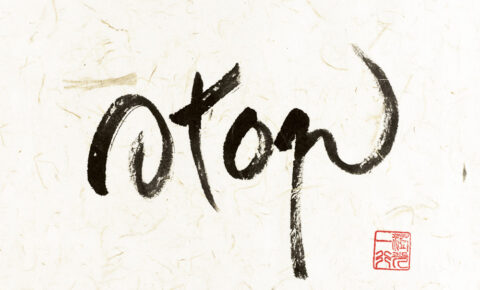
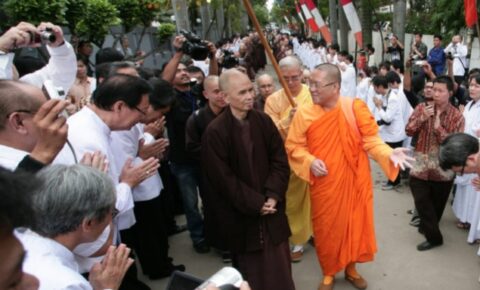
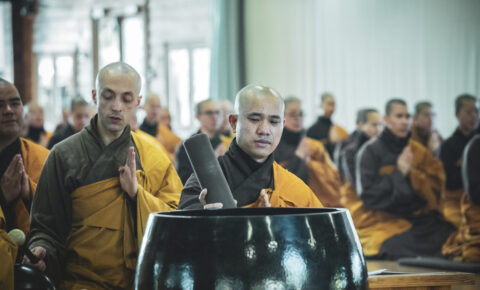
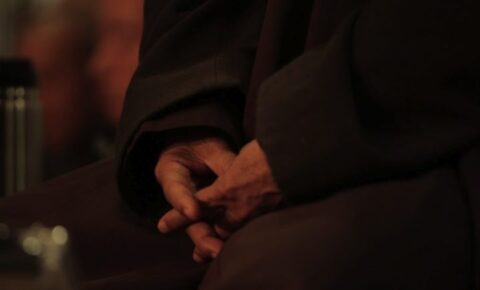
Ikut percakapan